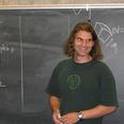
Article
Zero-Reabsorption Doped-Nanocrystal Luminescent Solar Concentrators
ACS Nano
(2014)
Abstract
Optical concentration can lower the cost of solar energy conversion by reducing photovoltaic cell area and increasing photovoltaic efficiency. Luminescent solar concentrators offer an attractive approach to combined spectral and spatial concentration of both specular and diffuse light without tracking, but they have been plagued by luminophore self-absorption losses when employed on practical size scales. Here, we introduce doped semiconductor nanocrystals as a new class of phosphors for use in luminescent solar concentrators. In proof-of-concept experiments, visibly transparent, ultraviolet-selective luminescent solar concentrators have been prepared using colloidal Mn2+-doped ZnSe nanocrystals that show no luminescence reabsorption. Optical quantum efficiencies of 37% are measured, yielding a maximum projected energy concentration of ∼6x and flux gain for a-Si photovoltaics of 15.6 in the large-area limit, for the first time bounded not by luminophore self-absorption but by the transparency of the waveguide itself. Future directions in the use of colloidal doped nanocrystals as robust, processable spectrum-shifting phosphors for luminescent solar concentration on the large scales required for practical application of this technology are discussed.
Disciplines
Publication Date
2014
Citation Information
Stephen R. McDowall, Christian S. Erickson, Liam R Bradshaw, John D. Gilbertson, et al.. "Zero-Reabsorption Doped-Nanocrystal Luminescent Solar Concentrators" ACS Nano Vol. 8 (2014) p. 3461 Available at: http://works.bepress.com/stephen_mcdowall/17/
